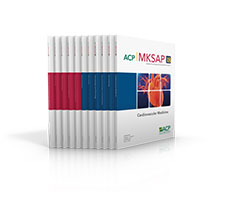Update your Knowledge with MKSAP 18 Q&A
 MKSAP has been trusted by internists since 1967 as the best resource for updating knowledge. MKSAP 18, available in Complete, Digital, and Print packages, consists of 11 comprehensive text chapters with related multiple-choice questions. You'll find 1,200 completely new questions to help you identify learning gaps, stay current, and gain the knowledge you need to provide the best possible patient care. MKSAP 18's original and high-quality questions evolve out of case studies and patient scenarios based on the latest evidence.
MKSAP has been trusted by internists since 1967 as the best resource for updating knowledge. MKSAP 18, available in Complete, Digital, and Print packages, consists of 11 comprehensive text chapters with related multiple-choice questions. You'll find 1,200 completely new questions to help you identify learning gaps, stay current, and gain the knowledge you need to provide the best possible patient care. MKSAP 18's original and high-quality questions evolve out of case studies and patient scenarios based on the latest evidence.
For more information on MKSAP 18, or to order your copy, visit mksap18.acponline.org.
MKSAP 18 Q & A
A 19-year-old man is brought to the emergency department after he attended a party with friends. He is anxious and tremulous. He has a history of depression. His only medication is fluoxetine.
On physical examination, he is alert and oriented. Temperature is 38.9 °C (102 °F), blood pressure is 136/79 mm Hg, pulse rate is 112/min, and respiration rate is 20/min. Oxygen saturation is 98% breathing ambient air. Physical examination is notable for slow, continuous, horizontal eye movements; tremor of extremities; hyperreflexia; and sustained ankle clonus and spontaneous myoclonus. The physical examination is otherwise normal.
Urine toxicology screening is pending.
Which of the following is the most likely diagnosis?
A: Anticholinergic toxicity
B: Malignant hyperthermia
C: Neuroleptic malignant syndrome
D: Serotonin syndrome

